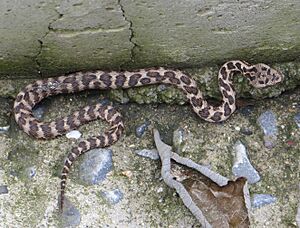Gloydius saxatilis facts for kids
Quick facts for kids Gloydius saxatilis |
|
|---|---|
 |
|
| Juvenile Sobaeksan National Park, S. Korea | |
| Conservation status | |
| Scientific classification | |
| Synonyms | |
|
The Amur viper, also known as the rock mamushi (scientific name: Gloydius saxatilis), is a type of venomous snake. It belongs to a group called pit vipers. This snake lives only in certain parts of the world: Russia, China, and the Korean Peninsula. Scientists do not currently recognize any different types or subspecies of this snake.
Contents
About the Amur Viper
The Amur viper has a body that is thicker than many other vipers. On top of its head, you can often see a marking shaped like an upside-down "V". Unlike some other vipers, it does not have white lines on its head.
Where Amur Vipers Live
Amur vipers can be found in mountain areas. They often live near streams and in forests. This means they like places with rocks, water, and trees.
What Its Name Means
The scientific name for this snake, saxatilis, comes from a Latin word. It means "found among rocks." This name fits well because these snakes often live in rocky places.
Geographic Range of the Amur Viper
You can find the Amur viper in eastern Siberia in Russia, northeastern China, and both North and South Korea. In 1934, a scientist named Chernov suggested that the main place where this snake was first described, called the type locality, should be limited to the "Suchan River" area in Primorskiy Kray, Russia.


